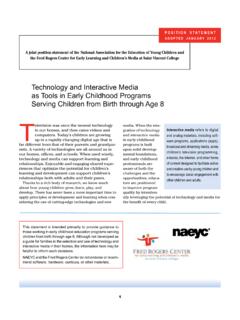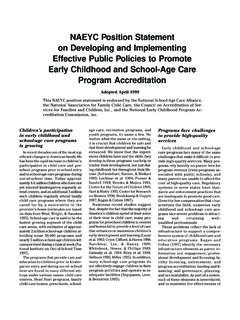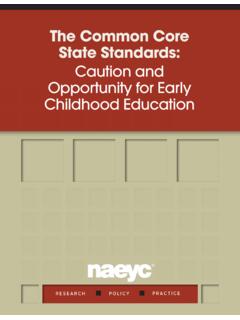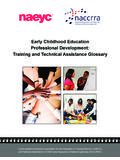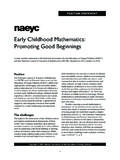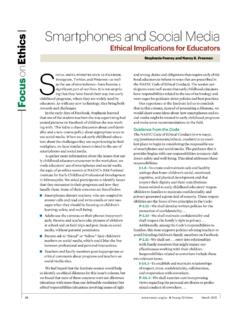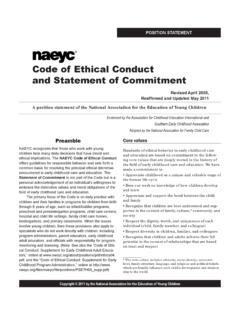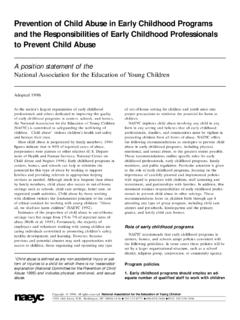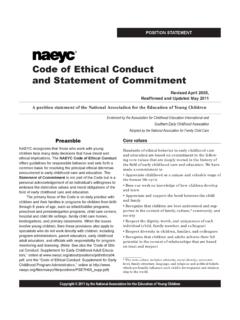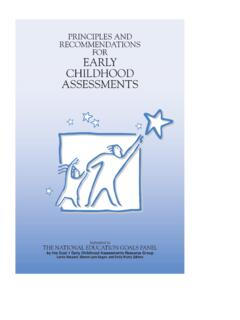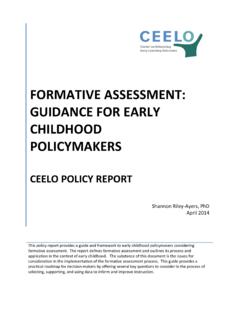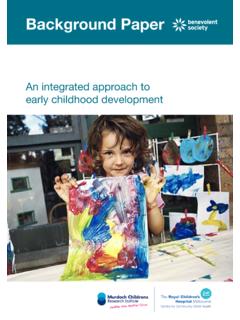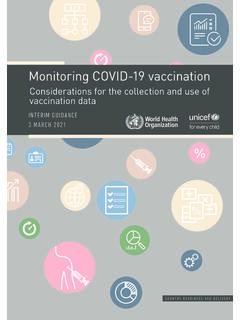Transcription of Early Childhood Inclusion - NAEYC
1 Early Childhood InclusionDivision for Early Childhood of theCouncil for Exceptional Children27 Fort Missoula Road | Missoula, MT 59804 Phone | Fax | Web Association for the Education of Young ChildrenEmail | an ever-increasing number of infants and young children with and without disabilities play, develop, and learn together in a variety of places homes, Early child-hood programs, neighborhoods, and other community-based settings. The notion that young children with disabilities1 and their families are full members of the community reflects societal values about promoting opportunities for development and learning, and a sense of belonging for every child. It also reflects a reaction against previous educational practices of separating and isolating children with disabilities. Over time, in combination with certain regulations and protections under the law, these values and societal views regarding children birth to 8 with disabilities and their families have come to be known as Early Childhood The most far-reaching effect of federal legislation on Inclusion enacted over the past three decades has been to funda-mentally change the way in which Early Childhood services ideally can be orga-nized and However, because Inclusion takes many different forms and implementation is influenced by a wide variety of factors, questions persist about the precise meaning of Inclusion and its implications for policy, practice, and potential outcomes for children and lack of a shared national definition has contributed to misunderstandings about Inclusion .
2 DEC and NAEYC recog-nize that having a common understand-ing of what Inclusion means is funda-mentally important for determining what types of practices and supports are neces-sary to achieve high quality Inclusion . This DEC/ NAEYC joint position state-ment offers a definition of Early Childhood Inclusion . The definition was designed not as a litmus test for determining whether a program can be considered inclusive, but rather, as a blueprint for identifying the key components of high quality inclu-sive programs. In addition, this document offers recommendations for how the posi-tion statement should be used by families, practitioners, administrators, policy mak-ers, and others to improve Early Childhood 2009A Joint Position Statement of the Division for Early Childhood (DEC) and the National Association for the Education of Young Children ( NAEYC )DEnaeyc2 Early Childhood Inclusion Definition of Early Childhood InclusionEarly Childhood Inclusion embodies the values, policies, and practices that support the right of every infant and young child and his or her fam-ily, regardless of ability, to participate in a broad range of activities and contexts as full members of families, communities, and society.
3 The desired re-sults of inclusive experiences for children with and without disabilities and their families include a sense of belonging and membership, positive social relationships and friendships, and development and learning to reach their full potential. The defin-ing features of Inclusion that can be used to identify high quality Early Childhood programs and services are access, participation, and is meant by Access, Participation, and Supports?Access. Providing access to a wide range of learn-ing opportunities, activities, settings, and environ-ments is a defining feature of high quality Early Childhood Inclusion . Inclusion can take many dif-ferent forms and can occur in various organization-al and community contexts, such as homes, Head Start, child care, faith-based programs, recreation-al programs, preschool, public and private pre-kin-dergarten through Early elementary education, and blended Early Childhood education/ Early Childhood special education programs.
4 In many cases, simple modifications can facilitate access for individual children. Universal design is a concept that can be used to support access to environments in many different types of settings through the removal of physical and structural barriers. Universal Design for Learning (udl) reflects practices that provide multiple and varied formats for instruction and learning. udl principles and practices help to ensure that every young child has access to learn-ing environments, to typical home or educational routines and activities, and to the general educa-tion curriculum. Technology can enable children with a range of functional abilities to participate in activities and experiences in inclusive Even if environments and pro-grams are designed to facilitate access, some children will need additional individualized ac-commodations and supports to participate fully in play and learning activities with peers and adults.
5 Adults promote belonging, participation, and engagement of children with and without dis-abilities in inclusive settings in a variety of inten-tional ways. Tiered models in Early Childhood hold promise for helping adults organize assessments and interventions by level of intensity. Depending on the individual needs and priorities of young chil-dren and families, implementing Inclusion involves a range of approaches from embedded, routines-based teaching to more explicit interventions to scaffold learning and participation for all children. Social-emotional development and behaviors that facilitate participation are critical goals of high quality Early Childhood Inclusion , along with learn-ing and development in all other In addition to provisions addressing access and participation, an infrastructure of systems-level supports must be in place to under-gird the efforts of individuals and organizations providing inclusive services to children and fami-lies.
6 For example, family members, practitioners, specialists, and administrators should have access to ongoing professional development and support to acquire the knowledge, skills, and dispositions required to implement effective inclusive prac-tices. Because collaboration among key stakehold-ers ( , families, practitioners, specialists, and administrators) is a cornerstone for implementing high quality Early Childhood Inclusion , resources and program policies are needed to promote multiple opportunities for communication and collaboration among these groups. Specialized services and therapies must be implemented in a coordinated fashion and integrated with general Early care and education services. Blended Early Childhood education/ Early Childhood special educa-tion programs offer one example of how this might be Funding policies should promote the Early Childhood Inclusion 3pooling of resources and the use of incentives to increase access to high quality inclusive opportu-nities.
7 Quality frameworks ( , program quality standards, Early learning standards and guide-lines, and professional competencies and stan-dards) should reflect and guide inclusive practices to ensure that all Early Childhood practitioners and programs are prepared to address the needs and priorities of infants and young children with disabilities and their for Using this Position Statement to Improve Early Childhood ServicesReaching consensus on the meaning of Early child-hood Inclusion is a necessary first step in articu-lating the field s collective wisdom and values on this critically important issue. In addition, an agreed-upon definition of Inclusion should be used to create high expectations for infants and young children with disabilities and to shape educational policies and practices that support high quality in-clusion in a wide range of Early Childhood programs and settings. recommendations for using this posi-tion statement to accomplish these goals include:Create high expectations for every child 1.
8 To reach his or her full potential. A defi-nition of Early Childhood Inclusion should help create high expectations for every child, regardless of ability, to reach his or her full potential. Shared expectations can, in turn, lead to the selection of appropriate goals and support the efforts of families, practitioners, individuals, and organizations to advocate for high quality Inclusion . Develop a program philosophy on inclu-2. sion. An agreed-upon definition of Inclusion should be used by a wide variety of Early Childhood programs to develop their own philosophy on Inclusion . Programs need a phi-losophy on Inclusion as a part of their broader program mission statement to ensure that practitioners and staff operate under a similar set of assumptions, values, and beliefs about the most effective ways to support infants and young children with disabilities and their families. A program philosophy on Inclusion should be used to shape practices aimed at ensuring that infants and young children with disabilities and their families are full members of the Early Childhood community and that children have multiple opportunities to learn, develop, and form positive relationships.
9 Establish a system of services and sup-3. ports. Shared understandings about the meaning of Inclusion should be the starting point for creating a system of services and supports for children with disabilities and their families. Such a system must reflect a continuum of services and supports that respond to the needs and characteristics of children with varying types of disabilities and levels of severity, including children who are at risk for disabilities. However, the design-ers of these systems should not lose sight of Inclusion as a driving principle and the foun-dation for the range of services and supports they provide to young children and families. Throughout the service and support system, the goal should be to ensure access, partici-pation, and the infrastructure of supports needed to achieve the desired results related to Inclusion . Ideally, the principle of natural proportions should guide the design of inclu-sive Early Childhood programs.
10 The principle of natural proportions means the Inclusion of children with disabilities in proportion to their presence in the general population. A system of supports and services should include incentives for Inclusion , such as child care subsidies, and adjustments to staff-child ratios to ensure that program staff can ad-equately address the needs of every child. 4 Early Childhood Inclusion Revise program and professional stan-4. dards. A definition of Inclusion could be used as the basis for revising program and profes-sional standards to incorporate high quality inclusive practices. Because existing Early Childhood program standards primarily reflect the needs of the general population of young children, improving the overall quality of an Early Childhood classroom is necessary, but might not be sufficient, to address the individ-ual needs of every child. A shared definition of Inclusion could be used as the foundation for identifying dimensions of high quality inclu-sive programs and the professional standards and competencies of practitioners who work in these settings.
